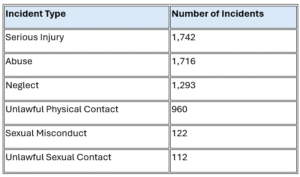A deep dive into NDIS staff turnover data
August 2, 2022

If you are a dedicated reader of Empathia Insights, you would know we have evaluated NDIS attendant care work data for the last year and have since launched an NDIS-specific Support Worker Engagement Tool. The data we collected and analysed revealed some worrying trends about the Disability Services sector that your organisation can address immediately by reviewing the structure of your exit and engagement processes.
Off the bat, staff turnover has worsened over the last few years, even though it was already reaching breaking point. In 2019, the NDS sector survey reported contract worker turnover at 20%, with casual staff approaching 28%. Our sector data indicates that full-time turnover is stable, but casual staff turnover has spiked to 38%.
Most interesting is that this turnover data has significant variances; the standard deviation for contract workers was 9%, while casual staff was 17% (not normally distributed, of course). Nevertheless, we find this data to be optimistic because it indicates that some organisations are getting this problem considerably wrong, which presents an opportunity to get it right.
This data could not be more timely, as the sector reports major shortages of attendant care staff despite the expanding NDIS and rapidly increasing demand for a relatively fixed workforce still recovering from COVID-19 disruptions.
In fact, we often hear from our networks that finding quality staff is the key barrier to growth and a significant determinant of expenses, as overtime and agency costs quickly erode thin margins. Lifestyle Solutions, a major player in the space, provides interesting data about this problem at scale. Their 2021 revenues exceeded $180mil, yet their margin was just 0.4%. In addition, they reported an agency staff expense of nearly $10mil. So it seems that staff shortages aren’t only affecting growth but can also erode margins and disrupt organisational culture.
Not all turnover is equal
A concerning trend unearthed in the exit data we collected (a common occurrence amongst many organisations we work with) is that attendant care staff are often “only” working in the industry while they gain other qualifications. In some cases, this turnover can explain up to 30% of an organisation’s staff churn. We call this “unavoidable turnover”.
While this finding might be obvious to those in the sector, the confounding effects of this turnover can be quite corrosive for organisations attempting to intervene.
A major hurdle for providers is attempting to pair exit data with engagement data. Often they find that staff leaving as a result of “unavoidable turnover” are far less likely to raise concerns about management or conditions, because the finite timeframe and “means to an end” psychology enable them to tolerate conditions that long-term staff could be much more sensitive to.
This finding is especially applicable when considering a major domain of turnover, the “this organisation actively provides me with development opportunities that are meaningful to me”, typically, this cohort is more likely to be satisfied since it doesn’t affect their career aspirations. The net effect of this “mixed cohort” design is that trends affecting your potential long-term staff can be understated or eliminated.
A straightforward solution to this trend is assigning a clear categorisation to your exit data to enable you to gain a better understanding of your exit determinants. We believe that staff who exit your organisation to perform a similar or identical role at another organisation are the key cohort to centre your engagement strategies around. These staff members understand that offers in the broader NDIS will be similar, and their exit reasoning will be much more relevant to the effectiveness of your Employer Value Proposition (EVP), management, and leadership capability. Categorising your data in this way will also help you identify a crucial externality of the scheme – client variability.
Avid readers of Empathia Insights may recall our review of the Taylor and Fry actuarial report, which demonstrated enormous funding variation for clients with the same level of intensity. This discrepancy is amplified in the attendant care space, where clients typically fall into “standard” or “higher intensity” cohorts. However, those in the NDIS know there is a tremendous amount of intensity variation within the standard cohort.
While disability support workers are among the most socially conscious and values-driven workers in our economy, organisations must acknowledge the “arbitrage” value of earning the same wages while working with far less intensive clients. Indeed, many disability support workers will raise concerns surrounding second-hand trauma, indicating the intensity of variation in this cohort. While the NDIS may not recognise variations in client intensity, if you wish to retain your staff, you will need to understand this and manage the allocation of shift intensity. Otherwise, your staff will do it themselves between organisations.
Getting to the facts
While our partners have been in the industry for a collective 30 years, new tools in evaluating NDIS support worker engagement have only recently revealed the extent to which endemic trends affect our industry.
The explosion of disability support work demand, especially in the context of “uberised” support, has given rise to conditions that were somewhat foreign in the days of block funding. The higher volume of “temporary” support workers has led to a blurring of data that makes evaluating the efficacy of your EVP much more difficult. However, by controlling this segment of the workforce, your capacity to identify and intervene in troubling aspects of your culture is considerably improved.
While more “temporary” support workers often make a valuable contribution to the effectiveness of the organisation, our view is that organisations should make deliberate efforts to set goals or limits for the size of this workforce. Undertaking this will enable you to anticipate “turnover spikes” that coincide with graduation dates and graduate programs. Identifying this cohort early also allows you to set turnover intervention targets that reflect the underlying capability of your organisation.
Once controlling for specific types of turnover and recruitment, you are free to measure engagement on a basis clear enough to have real impacts on your business.
In the “avoidable turnover” cohort, we see major trends. Firstly, many staff are dissatisfied with their managerial relationship, which manifests in four primary areas:
- My manager cares about me as a person (leadership)
- My manager administers our rosters fairly and with regard to my wellbeing (fairness)
- My manager has the technical knowledge to manage the behaviours and needs of my clients (technical skills)
- I receive sufficient training and development to advance my career (development).
You will notice that 50% of these domains won’t appear in a typical engagement survey, yet I’m sure that you’ll agree they are significant determinants of engagement and turnover in our sector. It is also worth noting that under the Disability Support Worker Cost Model (DSWCM) expectations of 15 FTE span of control, assuming a 20-hour contract and a 3-year supervisor tenure, most staff have a ~1% promotion chance each year. So while they probably haven’t crunched the numbers, in our experience, ambitious support workers have thought about these odds.
When taking an honest look at preventable turnover, we see some uncomfortable facts emerge. Promotional progress is extremely limited because of the structure of the DSWCM. Major variations in client intensity are typically not factored into wages or entitlements. There are major variations in how rosters are managed, how performance is measured, and the actual supervisory spans of control in the sector.
The only way to respond to these emerging facts is to take a serious look at your workplace conditions. Undertaking an honest assessment of the relative intensity of your clients and seeking to reward staff differently may be something to consider. Flattening your management structure to create a greater volume of promotional opportunities and importantly promotion signalling may be a crucial part in your EVP. Our view, however, is that simply having an Employee Assistance Program (EAP) and a gym subsidy does not begin to address the actual determinants of engagement and turnover. Only a genuine appraisal of the real conditions in support work will assist in keeping staff in your business who have many other opportunities.
The wrap-up
If you’re interested in reading more about this topic, we recommend you consider the work of Professor Beadle-Brown at La-Trobe (no she doesn’t pay us, we’ve never met, we just think her work is outstanding). Practice leadership is a significant determinant of Quality of Life (QoL) outcomes in Supported Independent Living (SIL). We strongly believe that staff engagement is not just affected by practice leadership, but mediated by customer QoL improvements. Taking a measured and solemn review of how frontline leaders tangibly support, mentor, and develop frontline staff will be key in the engagement process.
Like all complex problems, there are simple solutions, but they are usually wrong. Uncovering your staff engagement means understanding clearly what genuinely motivates your staff and what is aversive to them. This means that “easy” solutions, like having an EAP or “monthly values rockstar”, isn’t going to make a tangible difference. If you need assistance in getting to the bottom of your engagement, or you wish to have a conversation about real determinants, get in touch with us.
Share this article:
Continue reading Empathia Insights
Kafkaesque: The Moral Hazard at the Heart of SIL
Kafkaesque: The Moral Hazard at the Heart of SIL Dean Bowman November 18, 2025 Supported Independent Living The Federal Court's...


